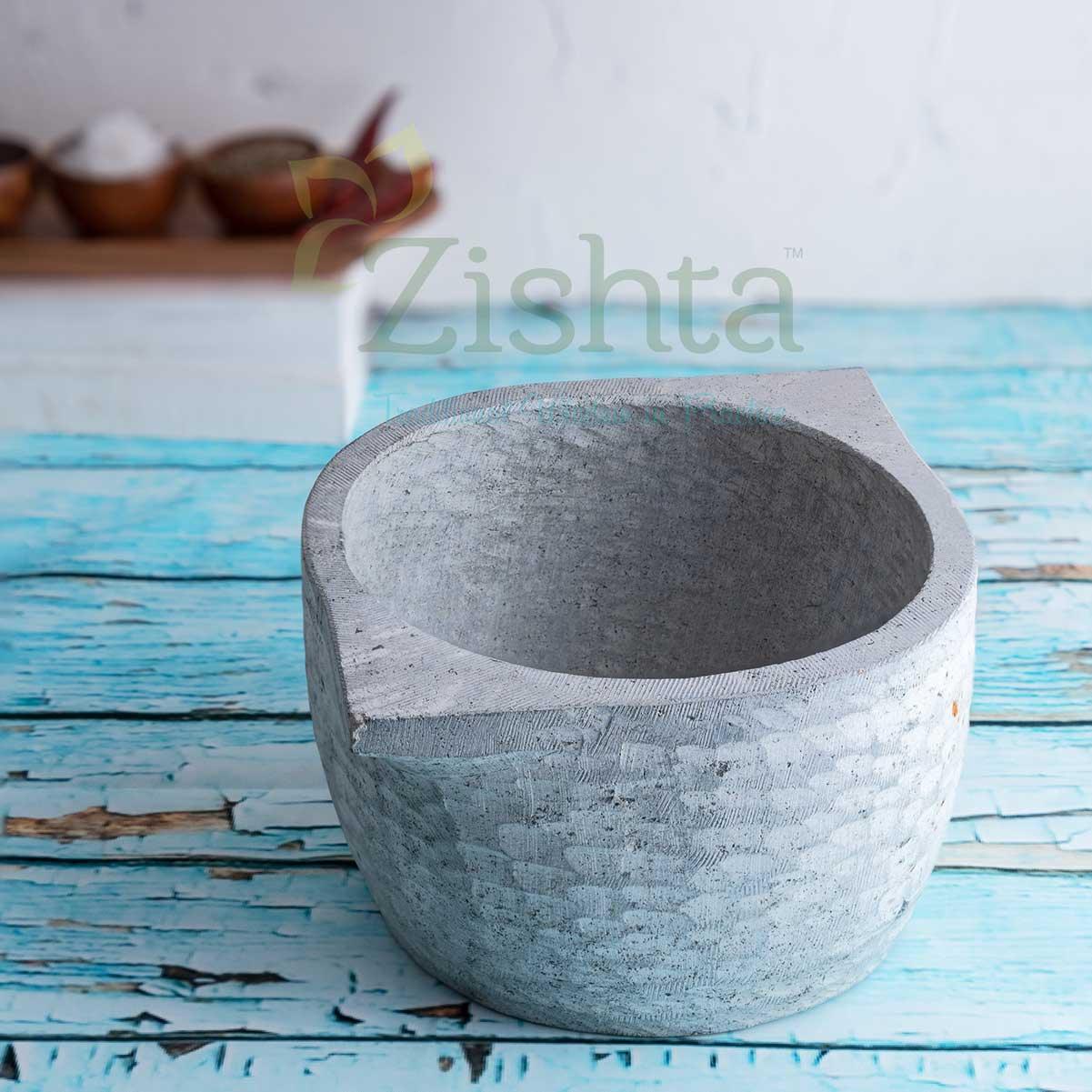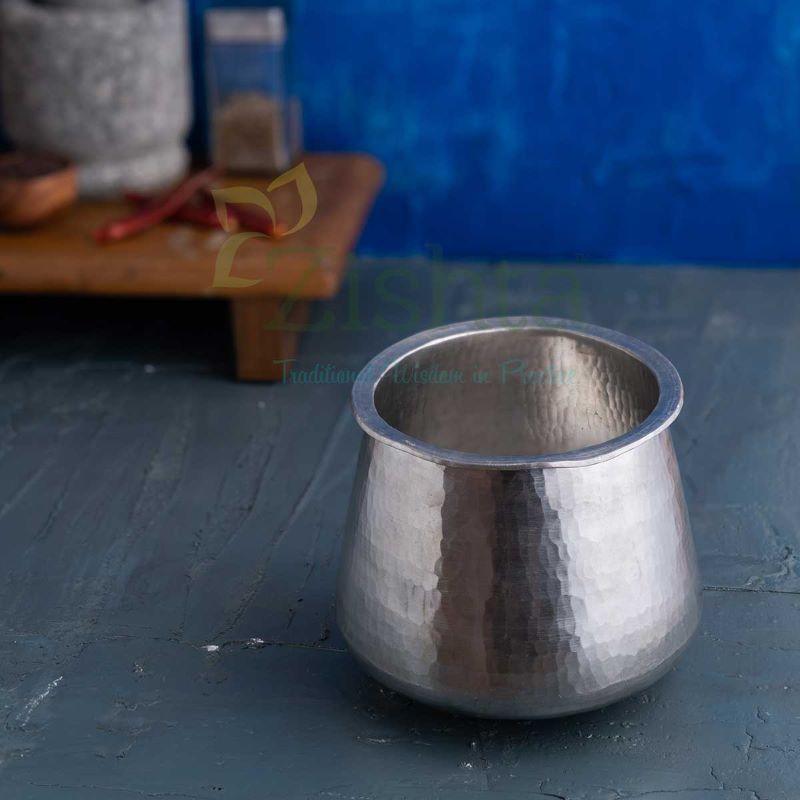The origin of Kalchatti
The use of soapstone for cookware in India dates back many centuries. Soapstone, also known as steatite, has been used for various purposes, including cooking vessels, due to its unique properties. It has excellent heat retention and can withstand high temperatures.

While it is challenging to pinpoint the exact date when soapstone cookware was first used in India, it has a long history in the country, with some estimates suggesting its use can be traced back to ancient civilizations. Soapstone cookware, such as pots and pans, has been used in various regions of India for cooking traditional dishes. These cookware items are especially prevalent in states like Rajasthan, Uttarakhand, and parts of South India.
The history of soapstone cookware in India is intertwined with its rich culinary traditions, and it continues to be used in many households for preparing a wide range of dishes.
How soapstone cookware is made
Soapstone cookware is typically crafted by skilled artisans using traditional techniques. Here's a general overview of the process of making soapstone cookware:
- Selection of Soapstone: The process begins with the selection of high-quality soapstone. Soapstone is a metamorphic rock known for its heat retention properties. The type and quality of soapstone chosen can affect the final product's performance and appearance.
- Cutting and Shaping: Once the appropriate soapstone is selected, it is cut into blocks or slabs using saws or other cutting tools. These blocks are then shaped into the desired cookware form, such as pots, pans, or cooking plates. This shaping can be done through various methods, including carving, grinding, or using specialized equipment.
- Rough Carving: The rough shape of the cookware is carved out, leaving space for further refining. This step helps in achieving the basic form and thickness of the cookware.
- Detailed Carving and Smoothing: Artisans then proceed to carve the cookware's interior and exterior, refining the shape, size, and thickness of the vessel. They pay careful attention to the design and functionality of the cookware.
- Finishing and Polishing: After the basic shape is achieved, the cookware is polished and smoothed to give it a sleek, finished appearance. This step can be labor-intensive, as artisans work to achieve the desired texture and finish.
- Heat Treatment: The finished cookware may undergo a heat treatment process to enhance its heat retention and durability. This process involves heating the cookware to high temperatures and then cooling it gradually. It can also affect the color of the soapstone, giving it a characteristic dark or mottled appearance.
How to season Kalchatti & Maintain them for long life
More than seasoning we need to look at ways to make sure we maintain this vessel, so they last for generations. Here is a blog article Maintenance Aspects of Soapstone to assist you with the same.
When using soapstone cookware, it's essential to take some key precautions to ensure the best cooking experience and maintain the longevity of the cookware. Here are some important precautions to keep in mind:
- Seasoning: Just like cast iron cookware, soapstone benefits from seasoning. Season your soapstone cookware by applying a thin layer of oil or fat to the interior surface and heating it. This helps in creating a natural non-stick surface and enhances its performance.
- Preheating: Gradually heat soapstone cookware to prevent thermal shock. Avoid placing cold soapstone directly on a hot burner, and don't expose it to rapid temperature changes.
- Slow Heating: Soapstone is excellent at retaining heat, but it can take a bit of time to heat up. Start cooking at a lower heat and gradually increase if necessary. High heat is not required for most cooking in soapstone.
- Avoid Drastic Temperature Changes: Never place a hot soapstone cookware item in cold water or on a cold surface, as this can cause cracks or damage.
- Avoid Dropping: Soapstone cookware is relatively soft compared to materials like cast iron, so it can chip or crack if dropped or subjected to heavy impacts. Handle it with care.
- Use Wooden or Silicone Utensils: To preserve the non-stick properties, use wooden, silicone, or other non-metallic utensils when cooking in soapstone. Metal utensils can scratch the surface.
- Regular Cleaning: After use, clean your soapstone cookware with warm water and a soft sponge or cloth. Avoid abrasive scouring pads or harsh detergents, as they can damage the surface.
- Dry Thoroughly: After washing, make sure to dry the cookware completely before storing it to prevent mold or mildew growth.
- Frequent Use: Soapstone cookware benefits from regular use. If left unused for extended periods, it may require re-seasoning to maintain its non-stick properties.
- Heavy Lifting: Soapstone cookware can be heavy, especially when filled with food. Use proper lifting techniques to avoid strain or injury.
- Inspect for Cracks: Periodically inspect your soapstone cookware for any cracks or damage. If you notice any issues, it's best to discontinue use and seek repairs if possible.
By following these precautions and taking good care of your soapstone cookware, you can enjoy its benefits and ensure it lasts for many years while providing you with excellent cooking results.
Benefits of cooking in Kalchatti
Cooking in soapstone cookware offers several benefits that make it a popular choice for many culinary enthusiasts. Here are some of the advantages of cooking in soapstone:
- Excellent Heat Retention: Soapstone has a remarkable ability to retain and evenly distribute heat. This property ensures that food is cooked consistently without hot spots or scorching. It's ideal for slow cooking and simmering.
- Energy-Efficient: Because of its heat retention properties, soapstone cookware can be used at lower heat levels, saving energy, and reducing fuel consumption. It retains heat long after the heat source is turned off.
- Natural Non-Stick Surface: Over time, with proper seasoning and use, soapstone develops a natural non-stick surface. This makes it great for cooking without excessive oil or fat, resulting in healthier meals.
- Versatile: Soapstone cookware can be used for a wide range of cooking methods, including frying, sautéing, roasting, baking, and simmering. It's suitable for both stovetop and oven cooking.
- Adds Unique Flavor: Cooking in soapstone can impart a subtle and unique flavor to dishes. Some people believe it enhances the taste of certain foods, making them more delicious.
- Durability: Properly cared for, soapstone cookware can last for generations. It is resistant to cracking and can withstand high temperatures without damage.
- Easy to Clean: Cleaning soapstone cookware is relatively straightforward. After cooking, you can simply wipe it down or wash it with warm water and a soft sponge. Avoid using abrasive cleaning materials.
- Attractive Appearance: Soapstone cookware has a natural, rustic appearance with its characteristic dark or mottled finish. It can add an aesthetic appeal to your kitchen and dining table.
- Retains Food's Temperature: Soapstone cookware not only retains heat while cooking but also retains the temperature of the food for longer, keeping it warm even after serving.
- Handcrafted and Unique: Many soapstone cookware pieces are handcrafted, making each one unique. This craftsmanship adds a sense of artistry and tradition to your cooking.
- Eco-Friendly: Soapstone is a natural material and is environmentally friendly, as it doesn't require the use of chemicals or artificial coatings.
- Micronutrient addition: Calcium, Magnesium are two critical micronutrients added to food when cooked in them.
- Alkaline property neutralizes acidity of the food cooked in them.
While cooking with soapstone has numerous advantages, it's essential to be aware of some considerations, such as its weight (it can be heavy), potential for chipping (due to its relative softness), and the need for regular seasoning and care to maintain its non-stick properties. However, for those who appreciate its qualities, cooking in soapstone can be a rewarding and enjoyable experience.




3 comments
Sunita mondal
I want ston and cust iron products
Aanchal Dey
I won’t this
PADMAJA
for 3 Nos family which RAchippa is better, extra small or medium. Please suggest and how to seasoning
Leave a comment
All comments are moderated before being published.
This site is protected by hCaptcha and the hCaptcha Privacy Policy and Terms of Service apply.